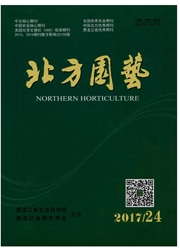

 中文摘要:
中文摘要:
以沙壤土和粘壤土分别做培养基支撑物进行枸子试管苗生根培养,试管苗的生根率、根长均明显高于琼脂支撑培养对照组。在沙壤土或粘壤土支撑培养条件下,培养基中不添加大量元素,可以显著提高枸子试管苗的生根率、根长等指标。以粘壤土做培养基支撑物,培养基中不添加微量元素和有机物,与添加者相比,生根率及根长无明显差异;培养基中添加蔗糖后,其生根率、根长等指标均明显高于未加蔗糖的处理,且培养基含蔗糖为1.5%的处理试管苗生根率达到93.3%,并显著高于含蔗糖为0.75%的处理。该研究结果可降低枸子试管苗成本,并为简化其移栽程序奠定基础。
 英文摘要:
英文摘要:
The stem sections of Cotoneaster hjelmqvistii planflets in vitro were cultured in the medium supported by sandy loam soil and clay loam soil respectively for rooting, and the rooting rate and the root length of the plantlet cultured in the soil supporting medium were obviously higher than those of the plantlet cultured in the medium supported by agar. When cultured in the medium supported by the soil, the rooting rate and the root length of the plantlet in the medium without adding macro-elements were obviously higher than those in the medium with macro-elements added. In the medium supported by the clay loam soil, the rooting rate and the root length of the plantlet cultured in the medium without micro-elements and organic materials were obviously higher than those in the medium with micro-elements and organic materials added. Besides, in the medium supported by the clay loam soil, the rooting rate and the root length of the plantlet in the medium with sugar added were obviously higher than those of the plantlets cultured in the medium without sugar, and the rooting rate of the plantlet in the medium with 1.5% sugar was 93.3%, which were obviously higher than that ofplantlet in the medium with 0.75% sugar. These results can reduce the cost and lay a foundation for simplifying the transplanting procedure of the Cotoneaster hjelmqvistii plantlets in vitro.
 同期刊论文项目
同期刊论文项目
 同项目期刊论文
同项目期刊论文
 期刊信息
期刊信息
